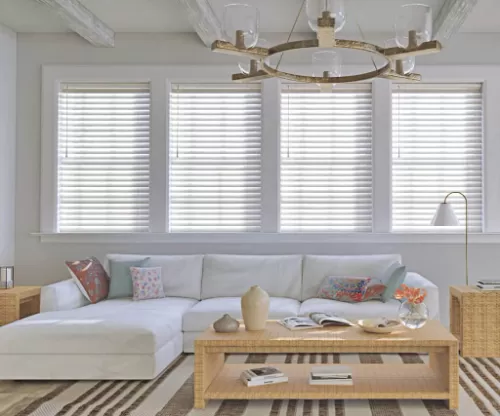

Click to Get Big Benefits

The Light Game: It's Not Just About Blocking the Sun
Natural light is beautiful — until it hits your screen during a Zoom call or wakes you up at 6:30 AM on a Saturday. That’s where window treatments come in. Sheer curtains can filter the light, softening harsh glare into a warm glow. Blackout blinds, on the other hand, are the ultimate weapon against unwelcome morning rays. It’s not about rejecting daylight altogether; it’s about controlling how and when it enters your space. Bonus: well-chosen curtains can help regulate indoor temperature, keeping things cooler in summer and warmer in winter. That’s function and fashion in one fell swoop.
Style with Substance: Why Fabric Matters
Not all curtains are created equal. There’s a vast difference between a stiff polyester panel and a lush velvet drape that puddles elegantly on your hardwood floor. Linen curtains offer a light, airy feel that works beautifully in coastal or boho-inspired spaces, while thick cotton or velvet options add weight, drama, and that “I hired a designer” look. As for blinds, wood and faux-wood slats offer timeless sophistication, while bamboo or woven styles bring in earthy, natural texture. Choosing the right material isn’t just about aesthetics — it’s about how your home feels.
Blinds vs. Curtains: A Battle Worth Having
So which team are you on? Team Blinds or Team Curtains? Blinds are minimal, practical, and great for smaller spaces or modern interiors. They offer precise control over light, especially Venetian and vertical styles. Curtains, meanwhile, bring softness and visual flow to a room. They can make ceilings appear taller, windows wider, and rooms cozier. But here’s the twist — you don’t actually have to choose. Pairing blinds with curtains is a design power move. You get structure from the blinds and softness from the curtains. Think of it as layering: jeans and a blazer, but for your window.
The Forgotten Spaces: Yes, Your Bathroom Deserves Better
Let’s not ignore the forgotten corners — your bathroom, laundry room, or that awkward hallway window. These spaces need privacy and light control too. Moisture-resistant blinds are perfect for bathrooms, while Roman shades or café curtains can soften a kitchen without overwhelming it. Even in tight spaces, window treatments matter. They provide visual cohesion and offer a chance to add subtle texture or color in places you didn’t think about decorating. Don’t underestimate what a crisp white Roman shade can do for an otherwise basic powder room.
Customization Without the Cost: Small Tweaks, Big Impact
Here’s a little secret: you don’t have to custom-order drapes to make them look custom. A few tricks — like hanging your curtain rod high and wide, using curtain rings with clips, or double layering sheer and blackout panels — can elevate store-bought options instantly. Even swapping out basic blinds for cordless versions or adding linen Roman shades can give your space a tailored, finished look. And if you’re handy with a sewing machine, trimming store-bought panels with ribbon or hem tape can create a designer look for under $20.
Mood Lighting Meets Window Dressing
You’ve probably thought about how lighting sets a mood — but have you ever thought about how your curtains affect that light? Soft, gauzy curtains let light bounce and billow, creating a dreamy, ethereal quality in the afternoon. Heavier fabrics can deepen shadows and create an atmosphere of calm. The way light diffuses through fabric — or is completely blocked by it — makes a room feel entirely different. This is especially important in multi-purpose spaces, like living rooms that double as home theaters. Window treatments allow you to dial in ambiance like a lighting pro.
Beyond Function: An Opportunity for Personality
Window treatments aren’t just background noise — they’re another place to express your personal style. Love maximalism? Go for patterned curtains in bold florals or graphic prints. Prefer minimalist vibes? Try clean-lined linen in neutral tones. Want to channel Parisian chic? Add elegant tie-backs or a double curtain rod with sheer and blackout layers. With so many colors, materials, and hardware choices, curtains and blinds can be just as expressive as a gallery wall — but a whole lot easier to change when your taste shifts.
How to Start: Small Steps, Big Change
If this all feels overwhelming, start small. Choose one room where light or privacy has been an issue — maybe your bedroom or home office — and experiment. Try swapping your heavy drapes for something lighter and brighter. Add a layer of bamboo blinds beneath your curtains. Or switch out tired plastic blinds for sleek wood ones. You’ll be surprised how much more cohesive and stylish your space feels with that one change. It’s a gateway decision — and yes, window treatment addiction is real.
Conclusion
At the end of the day, window treatments are like clothes for your home. They reflect your taste, offer comfort, and yes — occasionally hide a mess. So take them seriously, but don’t be afraid to play. Your home should feel like you, and every detail — even

All News
Others
- Terms of use
- Privacy Policy